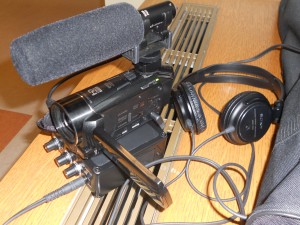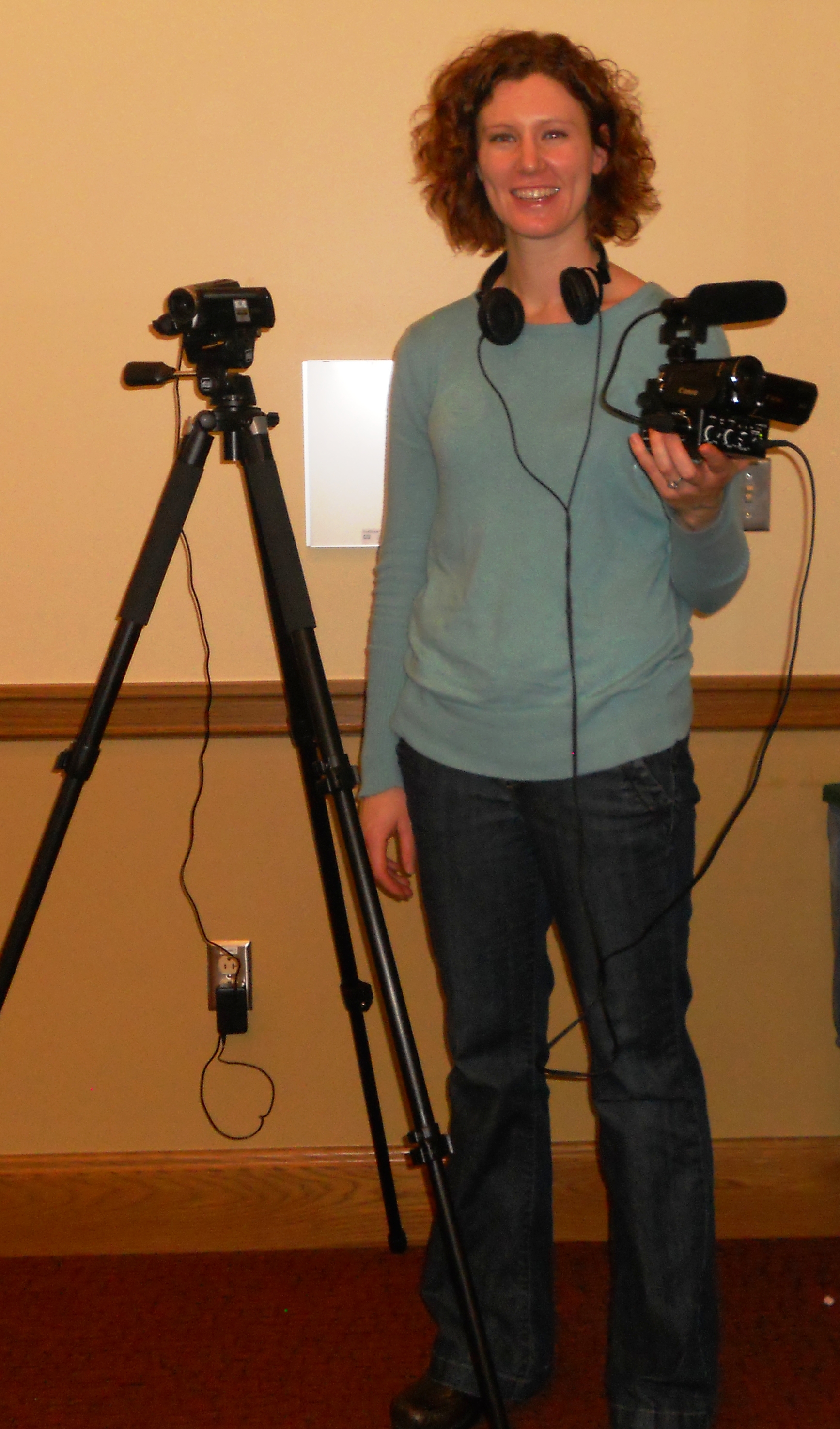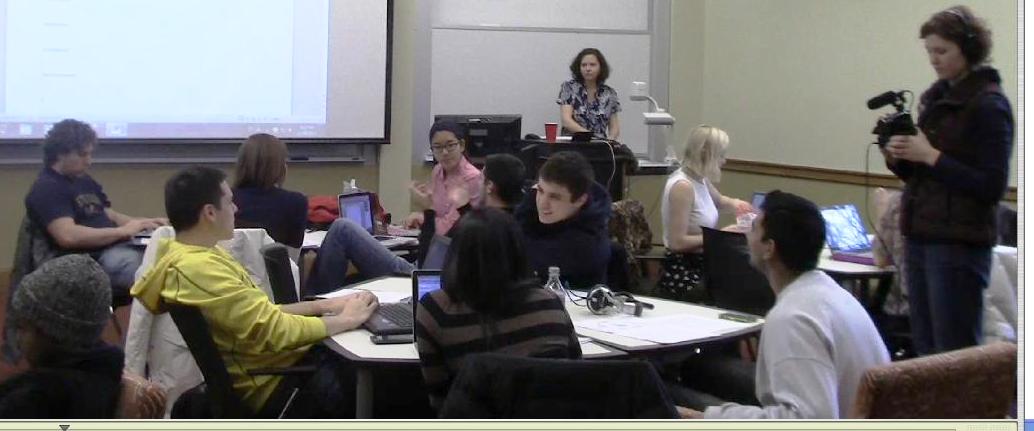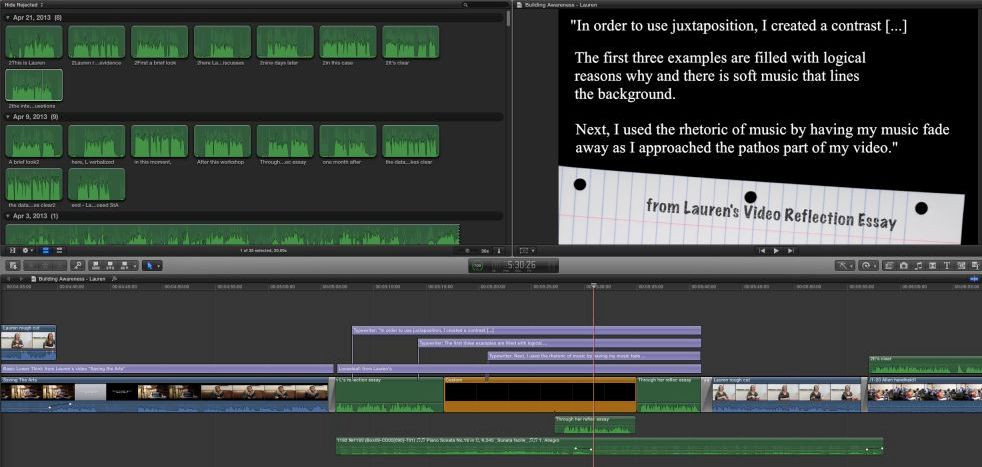A big part of my research is the collection and use of audio-visual (AV) qualitative data. I use video cameras and microphones to gather information about participants and their experiences, and I use video editing software to compose with this data as a part of the analysis and presentation of findings.
Let me be more specific about what this kind of AV research can look like. For my dissertation project, I conducted a qualitative study in two sections of first-year writing at a major university where each instructor included a unit of video composition as part of the curriculum. I collected several types of data as students composed their videos: I conducted and recorded multiple interviews with the instructors and students, I observed and recorded class lessons, and I collected documents.
To collect all of this audio-visual data, I brought cameras and microphones to class sessions and interview rooms. But I soon began to realize that the methodological and ethical choices an audio-visual researcher must consider and make are many, and that these choices have important implications for research participants and for the meaning that can be made from the data. For example, when I initially designed this study, I thought of a video camera solely as a recording device, but as I interviewed and recorded class sessions, I began to see that the camera functioned both as a recording tool and as an actor in the scene.
For one-on-one interviews, I decided to place the camera between me and the participant, and I sat behind the camera with headphones on. This set up required participants to look almost directly at the camera lens to make eye contact with me. I made this camera placement choice because I wanted a clear shot of the participants’ faces, and I wanted to highlight their responses.
For classroom observations, I lugged three video cameras, two tripods, and a shotgun mic to the classrooms I was studying – no small task in itself. I recorded with stationary cameras on tripods set in two corners, and I also walked around with a camera in my hand that had the shotgun mic mounted to its top, recording the sights and sounds directly in front of me. Moving around the room with a camera enabled me to capture particular interactions between students in a loud classroom environment where there were multiple people talking.
These AV data collection experiences have opened up many methodological questions for AV research that I am now considering: what is the effect on the data when participants are directed to ignore, interact with, or use video recording equipment in a classroom? Can an audio-visual researcher truly be a “participant-observer” in a research environment? What factors should influence a researcher’s decision about how many cameras to use, where to place cameras, and when to operate a camera? What camera angles are best for capturing classroom interactions and dialogue? Researchers might benefit from considering these kinds of questions explicitly as they design and implement AV research.
Now, as I am analyzing and writing up the findings of this study, I’m using the video data I collected in several ways, one of which is to compose short videos about the student experiences. I composed the video below about student-participant Lauren. For a more detailed account about how I composed this video and what I learned through the process, please read about my presentation at the Computers & Writing 2013 conference.
Transcript for video- Building Awareness of Composition through Video
From my experience composing this video about Lauren, I’ve learned that AV composition can shift and augment the process of data analysis. As I edited together Lauren’s interview clips with excerpts from her own video composition, for example, I began to think in new ways about the layered aspects of Lauren’s learning, about how a recursive process of doing and saying might have been occurring as she revised her video and wrote her reflection essay. AV composition allowed me to juxtapose several pieces of her data and to view and listen to them simultaneously, which was a very different experience than reading over written transcripts in isolation.
Other critical questions that arose as I conducted this study related to the ethical representation of participants. Seemingly simple decisions such as whether or not to use pseudonyms became complex due to the audio-visual nature of the data. I began to ask myself: can and should participant anonymity be protected when collecting and presenting video data? How do identifying factors that are seen and heard such as a participant’s gender, race, accent, or dialect become more evident in a research context where video data is collected and used, and what is the affect of the visibility of these factors on the presentation and analysis of data? Should the process of informed consent be required or extended for audio-visual research?
Overall, this study has taught me a lot about using cameras, microphones, and video editing software to collect, analyze, and present qualitative data, and as my questions reveal, I’m still learning and thinking through many of the implications. But the availability and accessibility of audio-visual recording and editing tools for research is opening up new possibilities for inquiry, and I’m excited to see (and hear) where we go next.





1 Comment
Pingback: Collecting AV Data; Composing AV Arguments | Compose, Revise, Reflect